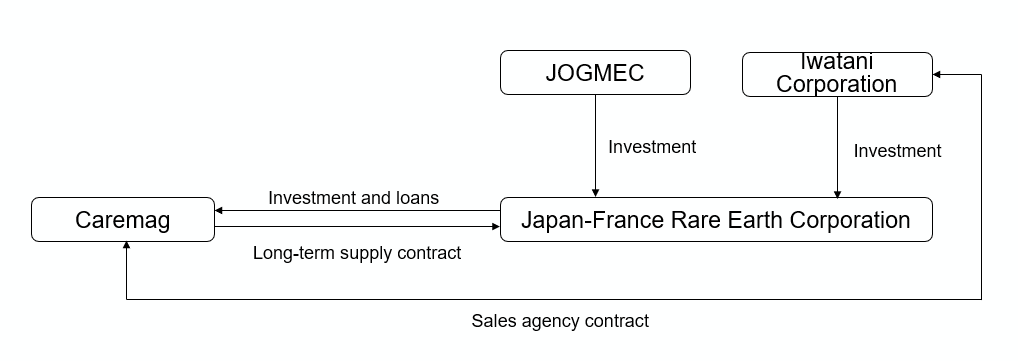- Home
- News Releases
- Back Issues
- March FY2025
- The Japanese and French Governments Work Together to Support a Heavy Rare Earth Project in France
The Japanese and French Governments Work Together to Support a Heavy Rare Earth Project in France
March 17, 2025
The Japanese and French governments welcome Iwatani Corporation (headquartered in Minato-ku, Tokyo, Japan) and Japan Organization for Metals and Energy Security (hereinafter “JOGMEC”; headquartered in Minato-ku, Tokyo, Japan) participation in the refining project to produce heavy rare earths planned by Caremag SAS (headquartered in Lyon, France; hereinafter “Caremag”) and the signing of a long-term supply contract for the stable supply of these elements to Japan. The governments of Japan and France have expressed their support for the project.
1.Outline of investment support
Caremag is currently planning to construct a rare earth plant in the Lacq industrial park in the Pyrénées-Atlantiques department in southwestern France to separate rare earths from 2,000 tons of recycled magnets and 5,000 tons of raw ore, to produce individual rare earth oxides. Recently, Iwatani Corporation and JOGMEC have participated in this project and signed a long-term supply contract, anticipating a supply equivalent to 20% of future Japanese demand for the produced heavy rare earths (dysprosium and terbium).
2.Outline of the Project
Referring to the “Japan-France Declaration on Cooperation in The Field of Critical Minerals” signed on May 1st, 2024, between the Minister of Economy, Trade and Industry (hereinafter “METI”) of Japan and the Minister of Economy, Finance and Industrial and Digital Sovereignty of the French Republic, METI has decided to contribute approximately 100 million euros to the project through JOGMEC. The French government has decided to support the project with approximately 106 million euros since the beginning of the project, including subsidies and tax credits.
In addition to financial cooperation for the project, both governments will work together to develop resource diplomacy, such as encouraging rare-earth producing countries to secure rare-earth raw materials. This is a new alternative supply project for heavy rare earths that does not depend on a specific country, and is a symbolic project of cooperation between Japan and France in the critical mineral industry.
Furthermore, a groundbreaking ceremony for this project is scheduled to be held on March 17 of this year in France, with the participation of H.E. Ms. Agnès Pannier-Runacher, Minister of Ecological Transition, Biodiversity, Forests, Sea and Fisheries, and H.E. Mr. Martin, Minister of Trade and French Nationals Abroad, and Mr. Urata Hideyuki, Deputy Director-General, Manufacturing Industries Bureau, METI.

(Reference) What are rare earths?
Rare earths are a type of rare metal, encompassing a total of 17 elements. They are essential materials for rare earth magnets used in electric vehicles, such as neodymium and dysprosium, as well as cerium and lanthanum, which are used in polishing agents for HDD glass substrates and automotive exhaust catalysts. Among rare earths, those with a higher atomic weight are classified as heavy rare earths, and elements like dysprosium and terbium are required as additives for magnets used in motors for electric vehicles, which need to maintain magnetic strength even in high-temperature environments exceeding 100°C.
“Rare earths” refers to a type of rare metals and is the collective name for the 17 elements listed below.
Sc |
Scandium |
Y |
Yttrium |
La |
Lanthanum |
Ce |
Cerium |
Pr |
Praseodymium |
Nd |
Neodymium |
Pm |
Promethium |
Sm |
Samarium |
Eu |
Europium |
Gd |
Gadolinium |
Tb |
Terbium |
Dy |
Dysprosium |
Ho |
Holmium |
Er |
Erbium |
Tm |
Thulium |
Yb |
Ytterbium |
Lu |
Lutetium |
|
|
|
|
|
|
Related Material
Division in Charge
Mineral Resources Division, Manufacturing Industries Bureau